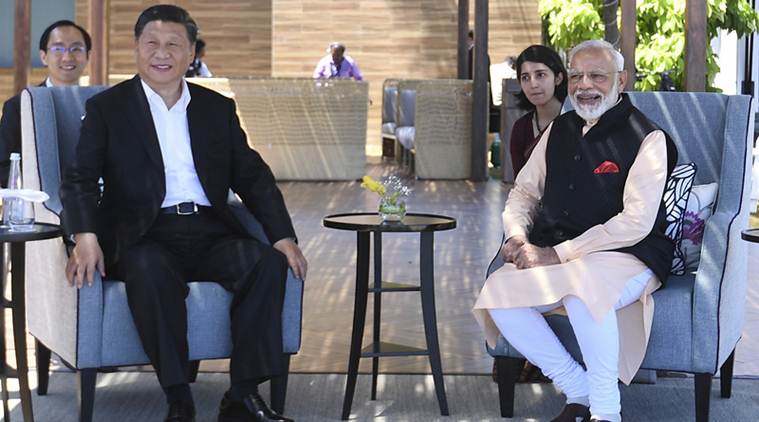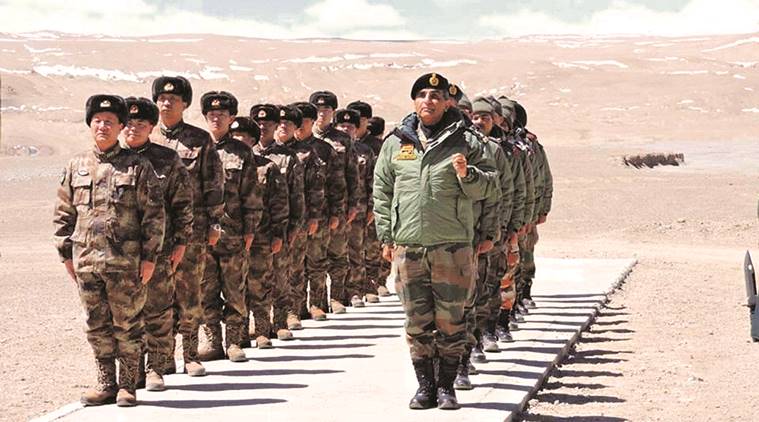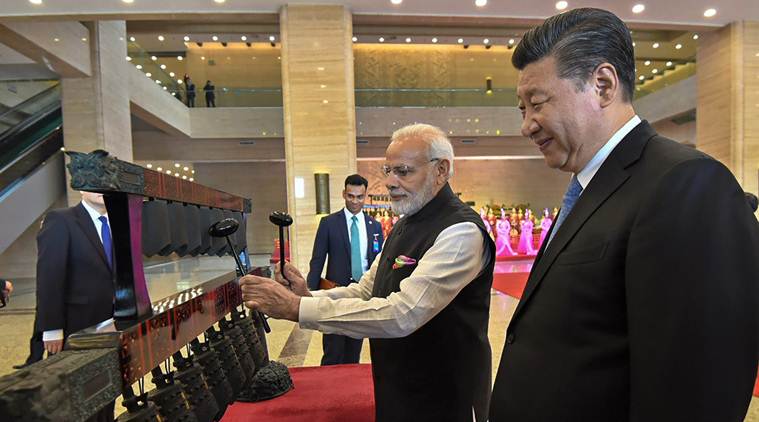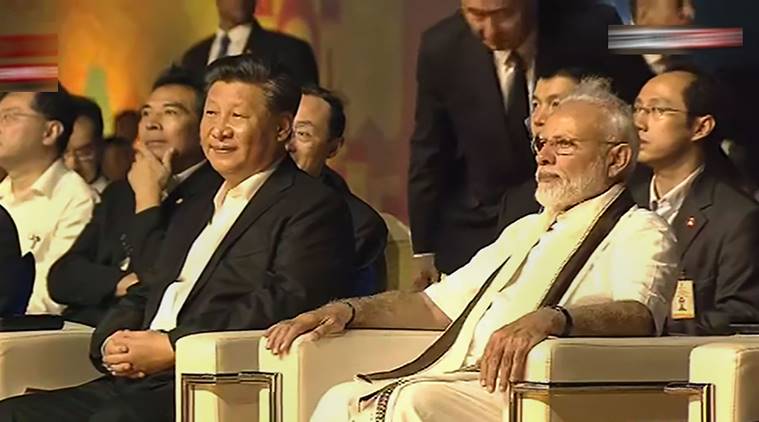 PM Modi met Chinese president Xi Jinping in Mahabalipuram for their second informal summit in October last year. It was their third meeting since Modi’s re-election in May 2019. (Press Information Bureau via AP)
PM Modi met Chinese president Xi Jinping in Mahabalipuram for their second informal summit in October last year. It was their third meeting since Modi’s re-election in May 2019. (Press Information Bureau via AP)
The killing of 20 Indian Army personnel including a Colonel-rank officer along the Line of Actual Control (LAC) has set off considerable disquiet in South Block. The “violent face-off,” New Delhi said, happened as a result of an attempt by the Chinese side to “unilaterally change the status quo” along the Line of Actual Control in Galwan valley.
The massive toll — biggest since 1967 border clash at the India-China border at Sikkim and the first combat casualties since 1975 — arising out of Monday night’s violence, officials said, strikes at the heart of every bilateral agreement and understanding to maintain peace and tranquility along the India-China border since 1993.
It also throws up new challenges in the already fraught road to de-escalation after 40 days of border stand-off — the longest in the last three decades.
The Indian government, for the first time since the stand-off began, said that the Chinese side “departed from the consensus to respect the Line of Actual Control (LAC) in the Galwan Valley”.
The Indian government’s statement came after the Chinese Foreign ministry said that “Indian troops on Monday seriously violated the consensus of the two sides by illegally crossing the border twice and carrying out provocative attacks on Chinese soldiers, resulting in serious physical clashes”.
In effect, both New Delhi and Beijing were accusing each other of violating or departing from the consensus. The “consensus” referred to is about the June 6 meeting between Lt General-rank officials.
 A file photo of Indian and Chinese personnel on the LAC. (ANI)
A file photo of Indian and Chinese personnel on the LAC. (ANI)
Indian Ambassador to China Vikram Misri met Chinese Vice Foreign minister Luo Zhaohui in Beijing Tuesday in the wake of these developments.
Giving an account of the situation, the Ministry of External Affairs’ official spokesperson Anurag Srivastava said that India and China have been discussing, through military and diplomatic channels, the de-escalation in Eastern Ladakh. Senior Commanders had a productive meeting on June 6 and agreed on a process for such “de-escalation”, he said. Subsequently, ground commanders had a series of meetings to implement the consensus reached at a higher level, he said.
“While it was our expectation that this would unfold smoothly, the Chinese side departed from the consensus to respect the Line of Actual Control (LAC) in the Galwan Valley,” the MEA spokesperson said.
 PM Modi has visited China five times, the most by any Indian PM in the last 70 years. In pic: PM Modi with Chinese President Xi Jinping visit an exhibition at Hubei Provincial Museum, in Wuhan (File/PTI)
PM Modi has visited China five times, the most by any Indian PM in the last 70 years. In pic: PM Modi with Chinese President Xi Jinping visit an exhibition at Hubei Provincial Museum, in Wuhan (File/PTI)
“On the late-evening and night of June 15, 2020 a violent face-off happened as a result of an attempt by the Chinese side to unilaterally change the status quo there. Both sides suffered casualties that could have been avoided had the agreement at the higher level been scrupulously followed by the Chinese side,” Srivastava said.
“Given its responsible approach to border management, India is very clear that all its activities are always within the Indian side of the LAC. We expect the same of the Chinese side,” he said.
Explained | Why China is flexing its muscle
“We remain firmly convinced of the need for the maintenance of peace and tranquillity in the border areas and the resolution of differences through dialogue. At the same time, we are also strongly committed to ensuring India’s sovereignty and territorial integrity,” he said.
Earlier in the day, after India said that it had lost one Army officer and two soldiers, China’s state-run Global Times quoted People’s Liberation Army (PLA) Western Theatre Command spokesperson Colonel Zhang Shuili as having said: “China always owns sovereignty over the Galwan Valley region… Indian troops seriously violated…the consensus made during the army commander-level talks and harmed the relations of the two militaries and the feelings of the two countries’ peoples.”
“India should stop all provocative actions, meet the Chinese side halfway and come back to the right path of solving disputes through talks, Zhang said”, it reported.
The faceoff comes a day ahead of the United Nations Security Council’s elections scheduled for June 17, where India is likely to be elected — unopposed — for the non-permanent member’s seat for a 2-year term, beginning January 2021.
The last such incident was reported when four Indian soldiers were ambushed and killed in Tulung La in Arunachal Pradesh in October 1975.
Officials said that the incident dents the diplomatic effort invested in nurturing the relationship between Prime Minister Narendra Modi and Chinese President Xi Jinping.
Both have met at least 18 times since Modi came to power in 2014. These include one-on-one meetings in each other’s countries and on the sidelines of the multilateral summits. The PM has visited China five times as the PM, the most by any Indian PM in the last 70 years.
 Both have met at least 18 times since Modi came to power in 2014. In pic: PM Modi with Chinese President Xi Jinping during a cultural function, in Mamallapuram in October last year (PTI)
Both have met at least 18 times since Modi came to power in 2014. In pic: PM Modi with Chinese President Xi Jinping during a cultural function, in Mamallapuram in October last year (PTI)
Last year, when they met in Mahabalipuram for their second informal summit in October, it was their third meeting since Modi’s re-election in May 2019.
Since 1993, India and China have signed several bilateral agreements and protocols to ensure peace and tranquility in the India-China border areas.
These agreements were the outcome of the re-building of the relationship with then Prime Minister Rajiv Gandhi’s visit in 1988. In 1993, the first such agreement between the two countries was signed during then PM P V Narasimha Rao’s visit to China and his meetings with Chinese Premier Li Peng. The outcome was the 1993 agreement on “Maintenance of Peace and Tranquility along the Line of Actual Control in the India-China border areas”.
Then followed the 1996 Agreement on “Confidence Building Measures in the Military Field along the LAC”, which was signed during Chinese President Jiang Zemin’s visit to India and his meetings with then PM H D Deve Gowda. This was followed by the Special Representative-level mechanism on border dispute was established in 2003 when then PM Atal Bihari Vajpayee went to China.
Thereafter, three pacts were signed during then Prime Minister Manmohan Singh’s 10-year stint — 2005 Protocol on Modalities for the implementation of the Confidence Building Measures in the Military Field along the LAC; the 2012 agreement on the establishment of a working mechanism for consultation and coordination on India-China Border Affairs; and 2013 Border Defence Cooperation Agreement.
Two of them were signed during then Indian Ambassador to China, S Jaishankar’s (now External Affairs minister) stint in Beijing.
In addition to these pacts, Modi and Xi have agreed that peace and tranquility will be maintained in two informal summits they have held — in Wuhan (April 2018) and Mahabalipuram (October 2019).
Road ahead more fraught
Prime Minister Narendra Modi and Chinese President Xi Jinping have met at least 18 times 2014. The PM has visited China five times as the PM, the most by any Indian PM in the last 70 years.
The understanding of each meeting, officials said, was to strengthen bilateral ties and keep the peace. Monday’s incident, officials said, not only undermines the diplomatic groundwork but makes the road ahead, including de-escalation, more challenging.